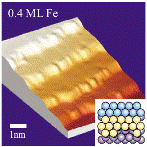Department of Physics and Astronomy: Publications and Other Research
Date of this Version
2010
Citation
JOURNAL OF APPLIED PHYSICS 107, 09E126 (2010); doi:10.1063/1.3365134
Abstract
The mesoscopic Kondo effect in metallic nanoparticles containing a magnetic impurity is investigated by model calculations. A Maxwell–Garnett approach is used to approximately determine the resistivity of doped nanoparticles in a matrix, and the magnetic susceptibility is estimated from the confinement of the conduction electrons. Conductivity measurements of nanoparticles embedded in a matrix are difficult to realize, because metallic matrices distort the Kondo cloud, whereas insulating or semiconducting matrices yield a very weak signal. By comparison, susceptibility measurements do not suffer from these shortcomings. The Kondo effect survives in nanoparticles even if the cluster size is much smaller than the Kondo screening cloud, but the effective Curie constant becomes constant below a particle-size dependent transition temperature and the temperature dependence of the susceptibility is no longer universal.


Comments
Copyright 2010 American Institute of Physics